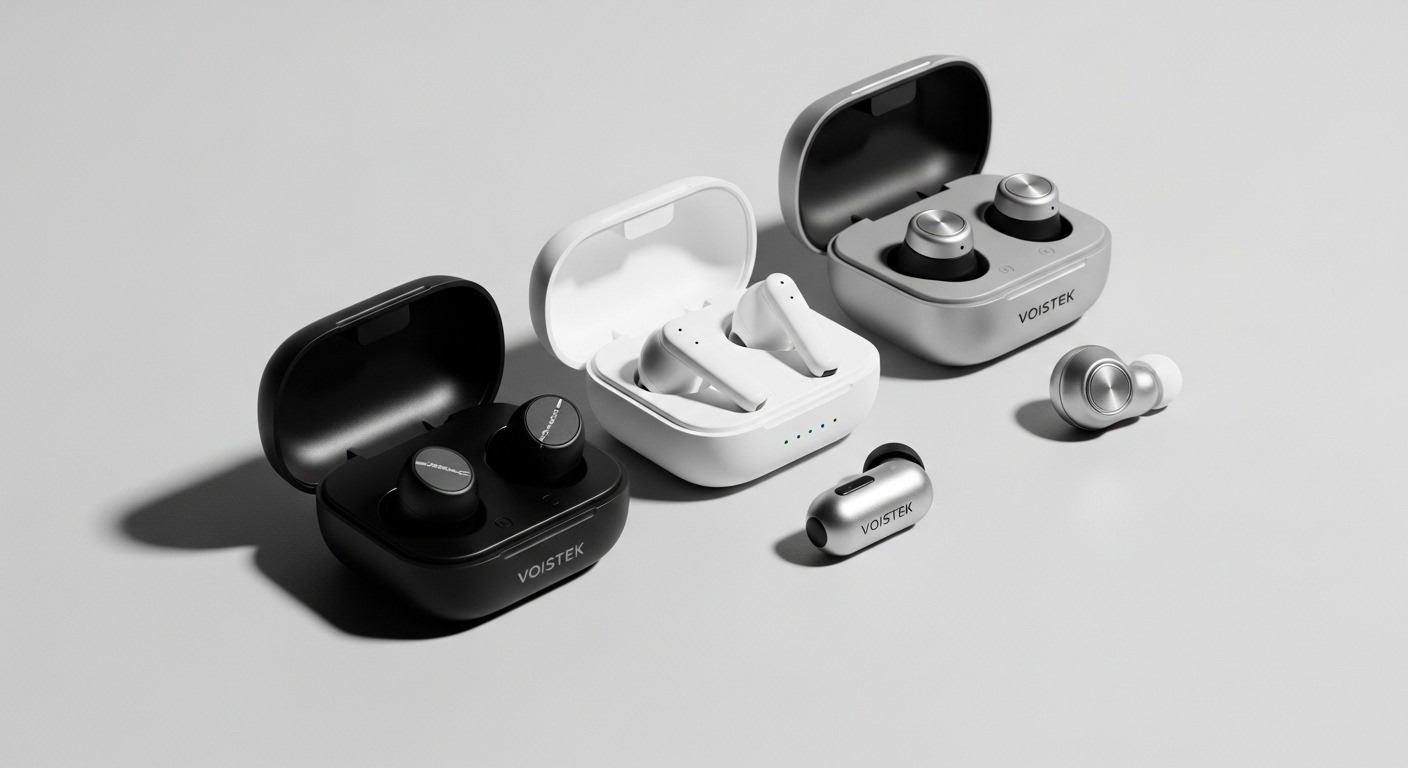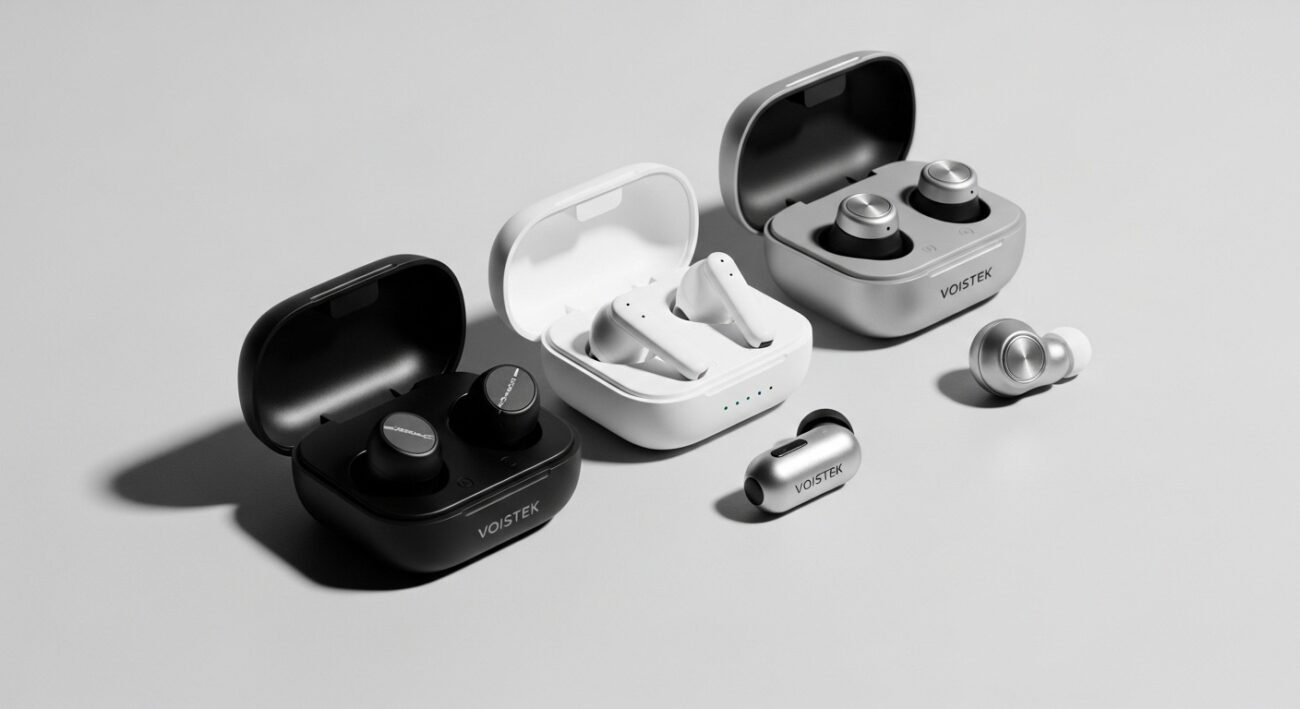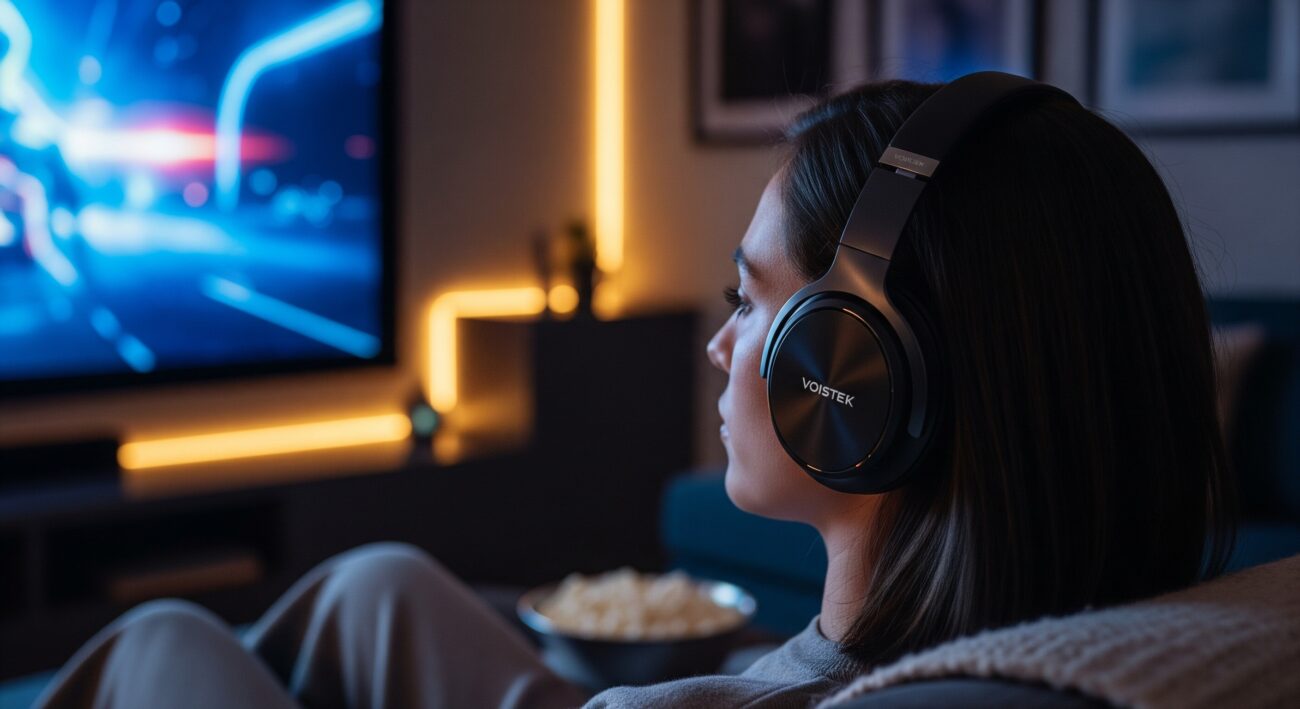Choosing the Right Small Wireless Headphones: A How-To Guide

The universal wince. That subtle, shared flinch on a packed morning train when someone’s over-ear headphones leak a tinny, private beat into public space. Or the frantic pat-down of your own pThe universal wince. That subtle, shared flinch on a packed morning train when someone’s over-ear headphones leak a tinny, private beat into public space. Or the frantic pat-down of your own pockets, the silent panic that your bulky audio companions have been left behind, severing you from your personal soundtrack. Our daily lives are a constant negotiation between our internal world and the external one, a dance of connection and disconnection. This is the modern soundscape, a delicate ecosystem where the right audio gear isn’t a luxury, but a necessity for sanity. It’s a quest for a personal bubble, a sonic sanctuary. And at the heart of this quest lies a technological marvel that has fundamentally altered our relationship with sound: small wireless headphones.
This isn’t just about buying a gadget. It’s about curating an experience. It’s about finding the perfect auditory prosthesis that feels less like a device and more like a seamless extension of your body and intent. The market is a dizzying array of promises, from bass-heavy powerhouses to devices so discreet they border on the clandestine. The goal here isn’t to crown a single winner. The goal is to equip you with a lens, a framework through which you can discern the subtle differences and find the pair that doesn’t just play music, but understands you.
Table of Contents
- 1 The Profound Power of the Petite: Why Miniaturization Wins
- 2 A Taxonomy of Tiny Sound: Deconstructing Form and Function
- 3 Decoding the Spec Sheet: The Features That Actually Matter
- 4 The Unseen Audio Revolution: A Deep Dive into Invisible Earbuds
- 5 Your Personal Audio Algorithm: Crafting the Decision Matrix
- 6 The Human Element: Post-Purchase Realities
- 7 Frequently Asked Questions
- 7.1 Q: What are the most important factors to consider when choosing small wireless headphones?
- 7.2 Q: How can I ensure small wireless headphones will be comfortable and not fall out?
- 7.3 Q: Is noise cancellation important for small wireless headphones?
- 7.4 Q: What is a realistic battery life expectation for small wireless headphones?
The Profound Power of the Petite: Why Miniaturization Wins
Let’s cast a fond, nostalgic glance at the giant, plush-covered headphones of yesteryear. They have their throne, especially for the at-home audiophile seeking immersive, room-shaking sound. But for the kinetic, on-the-move reality of contemporary life? Portability is not just a feature; it’s the entire thesis. Small wireless headphones, particularly their in-ear progeny, deliver a liberation that their larger counterparts can only dream of.
Consider the sheer physics of it. A charging case that slips into the fifth pocket of your jeans, the one that otherwise only collects lint and existential dread. They are a sartorial non-issue, refusing to annihilate a carefully curated hairstyle. You can rest your head on a pillow, side-sleeping without a bulky contraption digging into your skull. For the commuter, the runner, the office drone, the parent stealing a moment of peace—the advantages are profound, almost philosophical.
There’s a psychological dimension often overlooked. A less obtrusive device creates a softer boundary between you and your environment. You remain present, accessible. You can hear the station announcement, the barista calling your name, your child in the next room. And when you choose to withdraw, the transition is instantaneous. A tap, a swipe, and the world melts away, replaced by a private symphony or a calming podcast. I have a vivid memory of navigating a crowded grocery store with my old, formidable over-ear headphones. I felt like a satellite dish, awkwardly pivoting to avoid demoliting a pyramid of artisanal soup cans. Switching to a compact, discreet pair was an epiphany. I was no longer “the guy with the headphones.” I was just a guy, privately accompanied by his thoughts and his music.

A Taxonomy of Tiny Sound: Deconstructing Form and Function
To navigate this landscape, you must first understand its geography. Not all small wireless headphones are built to the same blueprint. The fundamental shape of the device dictates its personality, its strengths, and its inherent compromises. We can broadly categorize them into a few distinct archetypes.
The In-Ear Maestro: The Seal of Approval
This is the workhorse, the default champion for a reason. These models are engineered to nestle directly into your ear canal, typically accompanied by an array of silicone or foam ear tips. This is not a suggestion; it is the core of their functionality. The seal they create is everything. It’s the foundation for two critical audio properties: passive noise isolation and bass response.
A proper seal physically blocks ambient sound, letting your music dominate without needing electronic assistance. More importantly, it creates an acoustic chamber. Bass frequencies are felt as much as they are heard, and without a tight seal, they simply leak out, resulting in a thin, weak audio profile. A good seal makes the bass punchy and present. When reviewers tout the best small wireless headphones, they are often, though not always, referring to a well-executed in-ear design. They are the jack-of-all-trades, offering a compelling balance of audio fidelity, secure fit, and feature-set that works for the gym, the office, and the commute home. (Source: Guide to IEM Silicone Eartips)
The Stemmed Sentinel: A Design Dichotomy
Popularized by a certain Cupertino-based behemoth, this design is impossible to ignore. It features a stem that descends from the main body of the earbud, pointing towards your mouth. This aesthetic is polarizing. You either appreciate its iconic, almost futuristic silhouette, or you find it visually clunky.
Yet, the stem is not merely a stylistic flourish. It serves a distinct engineering purpose. By positioning the microphone closer to your mouth, it can significantly enhance voice pickup during calls, potentially outperforming designs where the mics are located further up on the bud itself. It also provides a convenient handle for tap and swipe gestures, a larger surface area for interaction. It’s a form factor that prioritizes communication and control, making its trade-offs a calculated choice.
The Phantom Drivers: The Rise of Invisible Earbuds
This is the bleeding edge of audio discretion, a category pushing the very limits of miniaturization. We are now in the realm of invisible earbuds—devices crafted to sit almost entirely within the concha, the bowl-shaped hollow of your outer ear. The objective is a “barely there” sensation, both physically and visually. For a growing number of users, this is the ultimate goal.
The appeal is multifaceted. It’s about social subtlety. In a meeting, a classroom, or a client-facing role, a visible piece of technology can send a certain message, intentional or not. Invisible earbuds allow you to listen to notes, a translation, or simply some calming ambient noise without broadcasting the fact. They are the audio equivalent of reading a book on your phone instead of holding up a massive hardcover. I once endured a multi-hour, mandatory corporate video conference. With a pair of these phantoms in place, a gentle stream of lo-fi hip-hop transformed the experience from monotonous to manageable. I was engaged, present, and audibly undistracted. My secret remained safe. The psychological boost was immeasurable.
Decoding the Spec Sheet: The Features That Actually Matter
The technical specifications for audio gear can read like alphabet soup: drivers, codecs, hertz, decibels. It’s enough to induce glazed-over eyes. Let’s distill this down to the practical elements that will tangibly affect your listening life. Forget the marketing fluff. Here’s what you actually need to comprehend.
Sonic Character: The Soul of the Sound
“Great sound quality” is a meaningless platitude. Sound is subjective, a deeply personal preference. The key is to understand the character of the sound.
- Driver Dynamics: This is the speaker inside the bud. A larger driver can potentially move more air, which can lead to more powerful bass. But this is a simplistic view. The engineering magic lies in the tuning—the way the audio is shaped and balanced by the manufacturer’s software and hardware. A brilliantly tuned small driver will always outperform a poorly tuned large one.
- Frequency Response Philosophy: This is the balance between bass, midrange, and treble. Many consumer-focused buds are “V-shaped,” meaning the bass and treble are boosted. This creates an exciting, energetic sound that works wonderfully for pop, rock, and electronic music. Other buds aim for a “neutral” or “flat” response, which doesn’t accentuate any frequency. This is preferred for acoustic, jazz, or classical genres where accuracy and detail are prized. Ask yourself: what is my soundtrack?
- The Codec Conundrum: This is the language your phone uses to talk to your headphones. It’s the method of Bluetooth compression. SBC is the universal baseline; it works fine. But if you have discerning ears, the codec support matters. AAC is well-optimized for Apple devices. aptX and its variants (aptX HD, aptX Adaptive) are generally superior on Android, offering higher bitrates and lower latency. LDAC is Sony’s high-resolution codec capable of transmitting significantly more data. It’s a deep rabbit hole, but the right codec partnership can mean the difference between hearing a song and feeling it.
Active Noise Cancellation (ANC): The Modern Miracle
This is the sorcery that defines premium audio today. ANC uses outward-facing microphones to listen to ambient noise—the drone of an airplane engine, the rumble of a subway car, the cacophony of an open office. It then generates a mirror-image “anti-noise” wave to cancel the invading sound before it reaches your ear drum. The effect can be genuinely breathtaking.
The best small wireless headphones feature multi-microphone, hybrid ANC systems that can adapt to different environments. They can turn a roaring vacuum cleaner into a distant whisper. Crucially, look for a “Transparency” or “Awareness” mode. This technology works in reverse, using the mics to pipe the outside world into your ears. It allows you to have a conversation, order a coffee, or remain aware of your surroundings without removing a single bud. It’s the ultimate control over your auditory reality.
Battery Existence: The Arithmetic of Endurance
The numbers are always presented as a duo: the bud’s life and the case’s total supplemental charges. A standard today is 5-8 hours of listening on the buds themselves, with the case adding another 20-30 hours. Read the fine print. These figures are often quoted with ANC disabled. Turn that feature on, and you might see that number drop by a third. It’s a trade-off of power for peace.
The charging case itself has become a product differentiator. Does it support wireless charging? This is a quality-of-life feature that feels like a luxury until you experience it, after which it becomes a non-negotiable. The simple act of dropping a case onto a pad instead of hunting for a USB-C cable is a small victory for convenience in a cluttered world.
The Anatomy of Comfort: Where Physics Meets Physiology
You could own the most acoustically perfect instruments ever created, but if they feel like jagged rocks in your ears after thirty minutes, they are failures. Fit is the single most personal and critical variable in this entire equation. It is the make-or-break.
- The Ear Tip Odyssey: The stock silicone tips are a starting point, not a conclusion. You must experiment. Try every single size. The goal is a snug, secure seal that doesn’t create pressure points. For the ultimate comfort and isolation, venture into the world of aftermarket memory foam tips. They compress, you insert, they expand to custom-mold to your unique ear canal. The difference can be night and day.
- Stabilizing Architecture: For the active user, this is paramount. Many models include wingtips or fins—small, flexible protrusions that lock into the anti-helix of your ear. They transform a potentially precarious fit into a rock-solid foundation, immune to the jostling of a run or a strenuous workout.
- The Gravity Factor: Weight is a silent antagonist to comfort. Every gram counts. This is a domain where the pursuit of invisible earbuds pays dividends. Their ultra-compact design often results in a remarkably low weight, allowing them to achieve that coveted “forget-you’re-wearing-them” sensation for hours on end.
Imagine this. You invest in the top-rated, five-star earbuds. You hit the pavement for a run. Within minutes, they feel loose. You’re constantly jamming them back into your ears, the music stuttering as the connection is broken. The frustration mounts. The experience is ruined. No amount of pristine sound quality can compensate for a fundamentally flawed fit.
The Unseen Audio Revolution: A Deep Dive into Invisible Earbuds
The trend toward ultra-discreet audio warrants its own dedicated analysis. This is more than a niche; for a significant segment, it’s the primary objective. The engineering required to cram a battery, a driver, Bluetooth radios, and microphone arrays into a package that virtually vanishes is a testament to human ingenuity.
The core value proposition is social and professional discretion. They are a tool for constant, private audio access without the social signaling of traditional earbuds. They are for the student who needs to listen to a recorded lecture during a study session in the library, the professional who takes back-to-back Zoom calls and needs a comfortable, unseen device, or the individual who simply prefers a minimalist aesthetic.
Yet, the laws of physics are unforgiving. To achieve this phantom-like form, compromises are inevitable. Battery life is often the first casualty, with single-charge durations typically shorter than their more prominent counterparts. The speaker drivers are necessarily smaller, which can limit the sheer physicality and impact of bass response. Furthermore, implementing top-tier Active Noise Cancellation is a monumental challenge without the external real estate for dedicated ANC microphones. The noise cancellation in these devices is often more passive (relying on the seal) than active.
So, is the phantom for you? The answer lies in a clear-eyed assessment of your priorities. If your life demands a device that is seen as little as it is heard, if all-day comfort for voice calls and moderate listening is your zenith, then this category will feel like it was crafted for you. If your world is governed by thunderous basslines and the need to completely obliterate the roar of a jet engine, you may find these ethereal buds lacking in raw power. It’s the classic trade-off: the sleek, agile sports car versus the capable, all-terrain SUV. Both are marvels of engineering, designed for entirely different journeys.
Your Personal Audio Algorithm: Crafting the Decision Matrix
You are now armed with the lexicon. The final step is to turn this knowledge inward. Instead of searching for a generic list of the best small wireless headphones, use these questions to generate your own personalized, prioritized shortlist.
The Activity Litmus Test
Where will these buds live their life?
The Urban Commuter/Traveler
Your holy trinity is powerful ANC, marathon battery life, and sublime comfort for extended wear. Transparency mode is a very close fourth.
- The Athlete and Runner: Your non-negotiables are an unshakeable fit (wingtips are essential), a high IPX rating for sweat and water resistance (IPX7 is the gold standard), and a secure, lightweight design. ANC might be a safety hazard here.
- The Office Nomad: Your priorities shift to discretion and comfort. Invisible earbuds shine here, as does a superb transparency mode for quick chats with colleagues. Long-term, all-day wearability is key.
- The Media Consumer: For gaming and movies, latency is your enemy. A dedicated low-latency “Game Mode” is critical to ensure the audio stays perfectly in sync with the on-screen action.
The Ecosystem Inquiry
Let’s be pragmatic. We live in walled gardens. If your phone, laptop, and tablet all bear the same fruit logo, the pairing and feature integration of that brand’s buds are often seamless to the point of magic. The same is true for the Samsung and Google ecosystems. Venturing outside your ecosystem isn’t forbidden, but be aware you might be sacrificing convenience features like automatic device switching and customized controls.
The Fiscal Reality Check
Define your battlefield. The price spectrum is vast, from budget-friendly to exorbitant. The sweet spot for exceptional performance, however, is firmly in the mid-range, roughly between $80 and $180. Here, the competition is ferocious, and you get phenomenal technology without the premium brand tax. Set a hard limit. Your perfect pair likely exists within it.
The “One Thing” Interrogation
What is your dealbreaker? Be brutally honest with yourself.
- Is it all-day battery?
- Is it microphone clarity that makes you sound like you’re in a studio?
- Is it a bass response that rattles your soul?
Or is it simply the ability to wear them for eight hours and forget they exist? Identifying this single, core demand will instantly eliminate half the options on the table, clearing a path to your audio soulmate.
The Human Element: Post-Purchase Realities
Even with meticulous research, the human experience contains variables no spec sheet can capture. Here are some final, slightly eclectic observations from the front lines of daily use.
The Control Conundrum
Touch controls are a universe of variance. Some are so sensitive that a stray strand of hair or an adjustment of a beanie can trigger a command. Others require a firm, deliberate press that can feel like you’re punching yourself in the side of the head. It’s a tactile interface that is notoriously difficult to perfect. Be prepared for a period of acclimation and occasional frustration.
The Case for the Case
Do not overlook the charging case. This is your buds’ home, their guardian. Is it slim and pocket-friendly, or a bulky brick? Does it open with a satisfying, one-handed snap, or does it require a fingernail-breaking effort? Is the lid wobbly? The tactile pleasure of a well-designed case contributes significantly to the overall satisfaction of ownership.
Microphone Fidelity
If your professional life is conducted over calls, this is your most important feature. A fantastic music-playing bud can have a terrible microphone. Seek out reviews that specifically test call quality in challenging environments—windy streets, noisy cafes. There is nothing less professional than sounding like you’re broadcasting from the center of a hurricane. Your voice is your instrument; ensure it is transmitted with clarity.
The Intangible “It” Factor
Sometimes, technology transcends its components. A pair of earbuds can just feel right. The specific tone of the connection chime. The satisfying, magnetic thunk as the buds settle into their case. The intuitive, lag-free connection process. This is the user experience, the gestalt of the product. It’s an alchemy that can elevate a good product to a beloved one.
The search for the perfect small wireless headphones is a pilgrimage of self-discovery. It is a process of aligning cold, hard technology with the warm, chaotic, and unique rhythm of your own life. The goal is not to find the pair that tops every chart, but the pair that disappears into your day, empowering your moments of focus, fueling your workouts, and providing the soundtrack to your journey. The silence is waiting to be filled. Your perfect audio companion is out there.
Frequently Asked Questions
Q: What are the most important factors to consider when choosing small wireless headphones?
A: Key factors include sound quality, battery life, comfort and fit (especially for smaller ears), connectivity stability, and the presence of useful features like noise cancellation or a reliable microphone for calls.
Q: How can I ensure small wireless headphones will be comfortable and not fall out?
A: Look for headphones that come with multiple sizes of ear tips or fins to customize the fit. Models designed specifically for a secure fit, such as those with ear hooks or a lightweight, ergonomic design, are often the best choice for active use.
Q: Is noise cancellation important for small wireless headphones?
A: Active Noise Cancellation (ANC) is a valuable feature if you frequently use headphones in noisy environments like planes, trains, or busy offices. It helps block out ambient sound, allowing you to listen at lower volumes. However, if you need to be aware of your surroundings, look for a model with a good transparency or ambient sound mode.
Q: What is a realistic battery life expectation for small wireless headphones?
A: Battery life varies, but most modern small wireless headphones offer between 5 to 8 hours of continuous playback on a single charge. The included charging case typically provides multiple additional charges, extending total battery life to 24 hours or more.
“The Spec Sheet Lies. Your Ears Don’t. Trial Period: 30 Days.”
Battery life claims are “lab fantasies.” Universal sound quality is a “meaningless platitude.” The perfect fit is “the make-or-break variable.” You’ve learned that real-world performance is what truly matters.
Voistek’s Radical Transparency Promise:
📊 Honest Battery Numbers
Advertised: 7 hours | With ANC: 6 hours | Actual mixed use: 5.5-6.5 hours
We quote real-world figures, not temperature-controlled lab fiction.
🎧 Tuning Philosophy Disclosed
Slightly V-shaped: Bass +3dB, Treble +2dB from neutral
Know the character before you commit. No “great sound quality” platitudes.
⚖️ The Weight Truth
4.8g per bud | Lighter than a nickel | Genuinely forget-you’re-wearing-them
🎤 Call Quality: Actually Tested
Beamforming mics tested in: windy streets, noisy cafes, vacuum cleaner hell
Your voice transmitted with clarity, not “broadcasting from a hurricane.”
💰 The Physics of Pricing
What you’re NOT paying for: Premium brand tax, celebrity endorsements, stadium advertising
What you ARE paying for: Engineering, materials, quality control
The Voistek Guarantee: If they don’t disappear into your day and empower your moments of focus, send them back. Zero questions. Zero friction.
[Experience the Difference →] | 30-Day Home Trial | Free Returns




